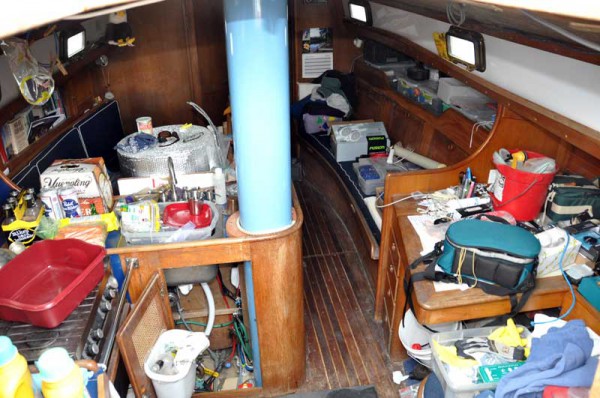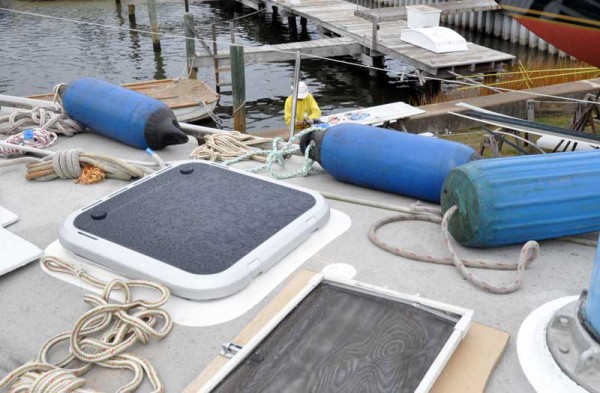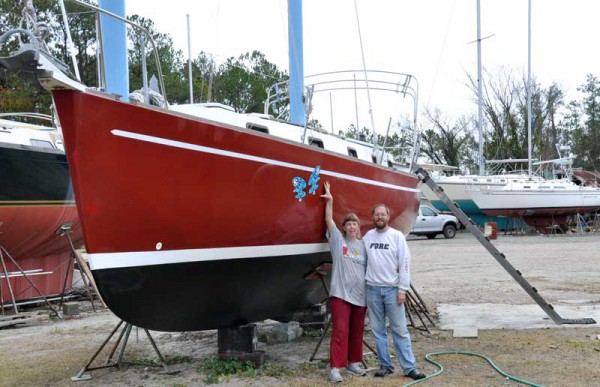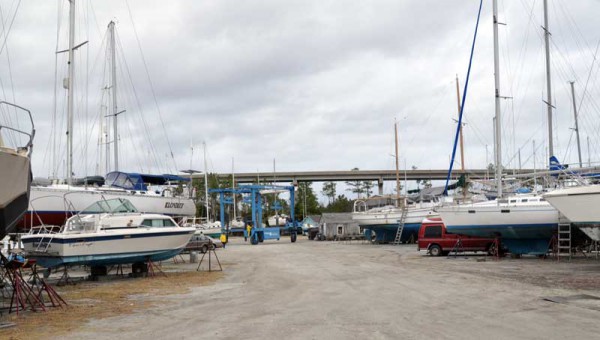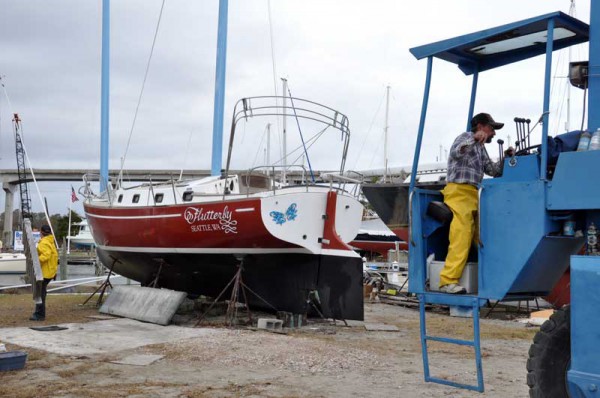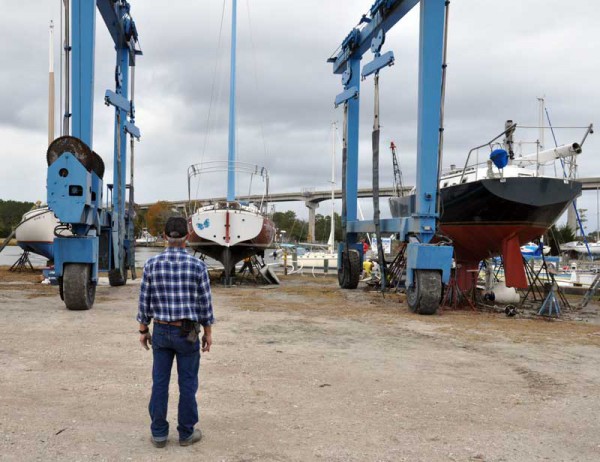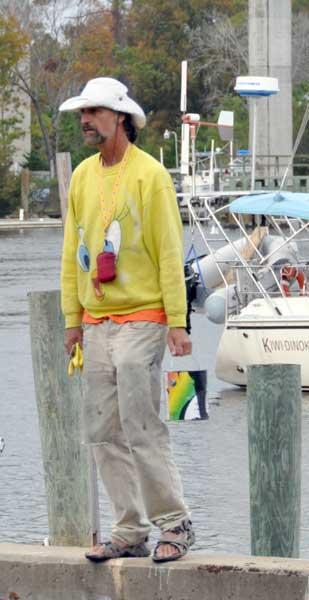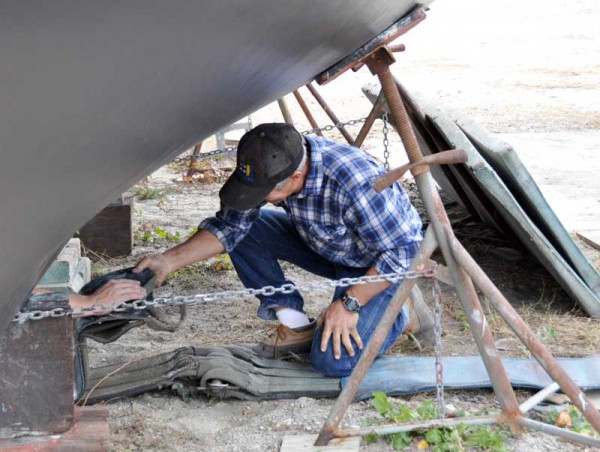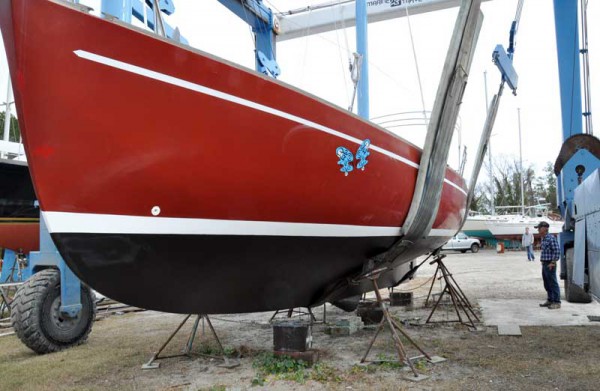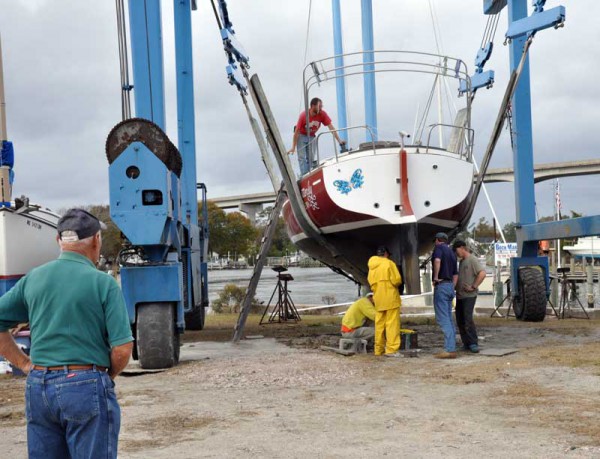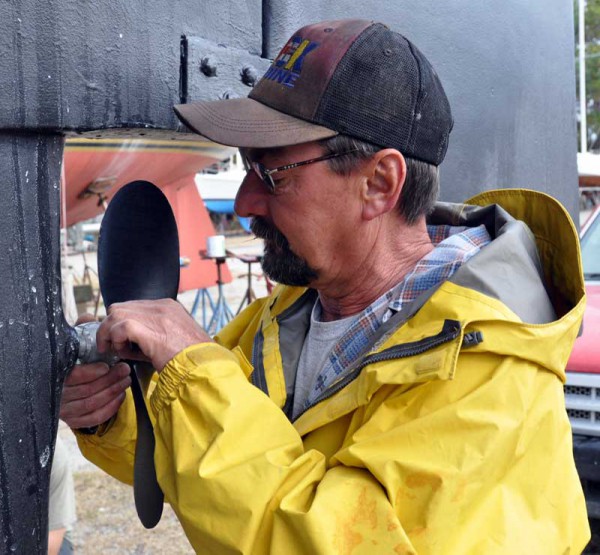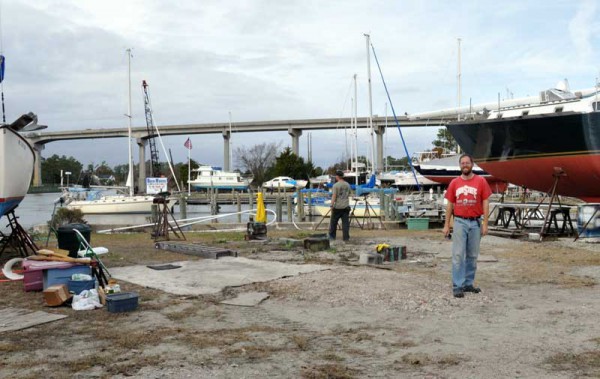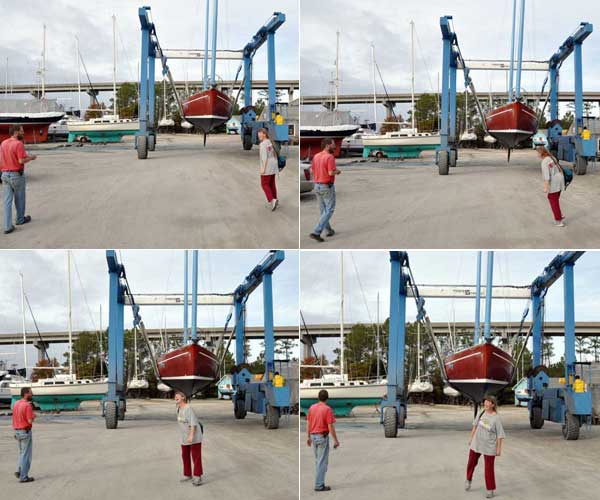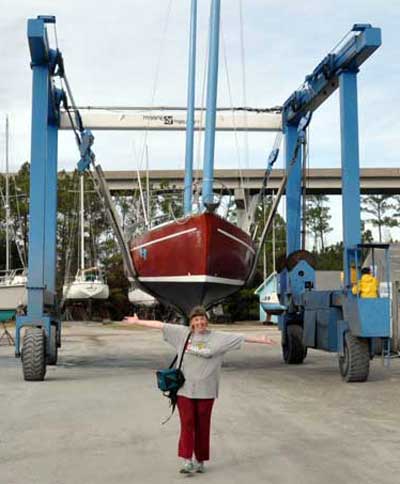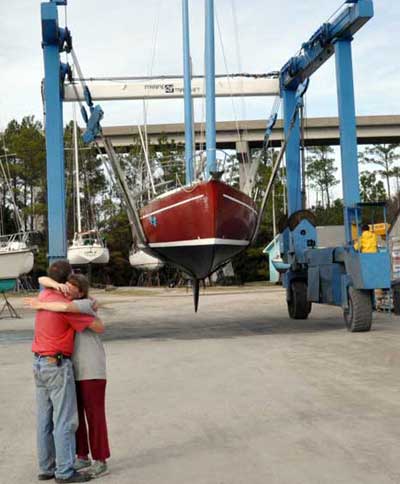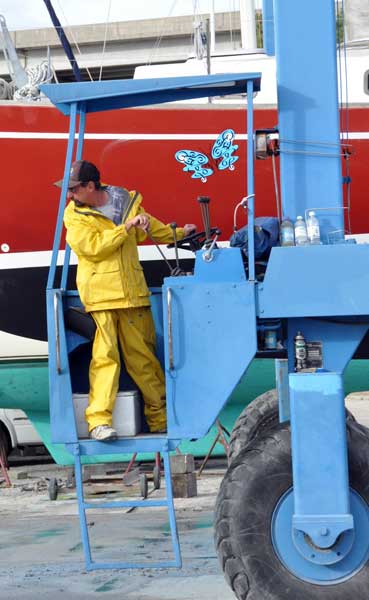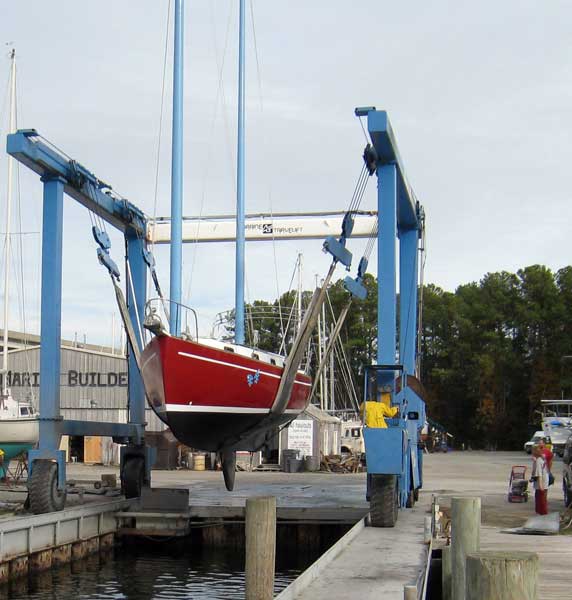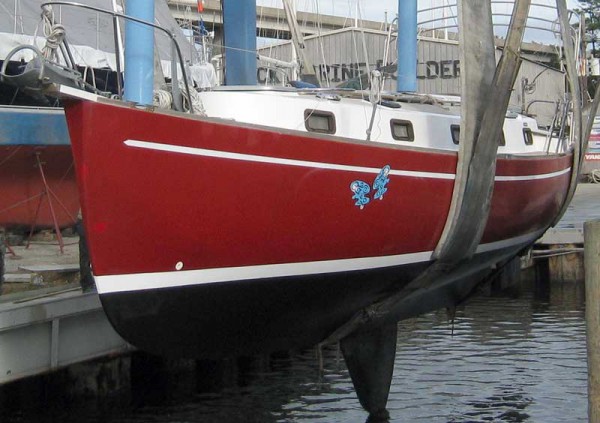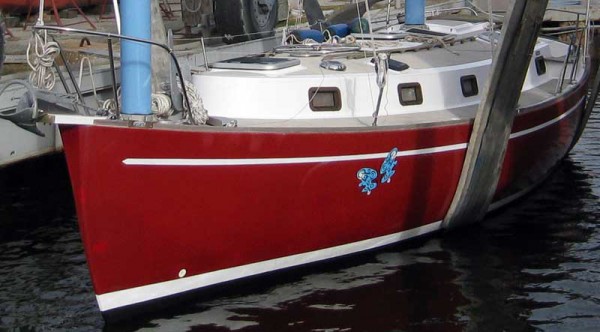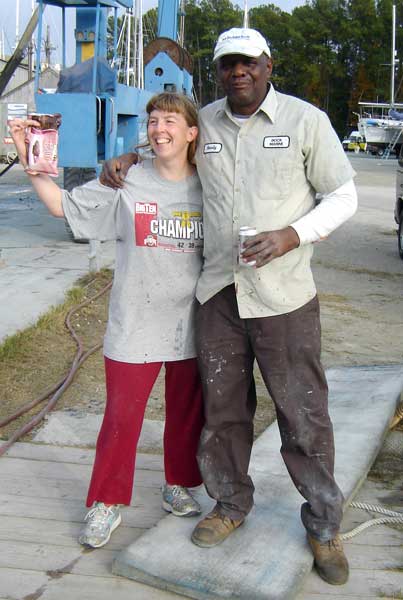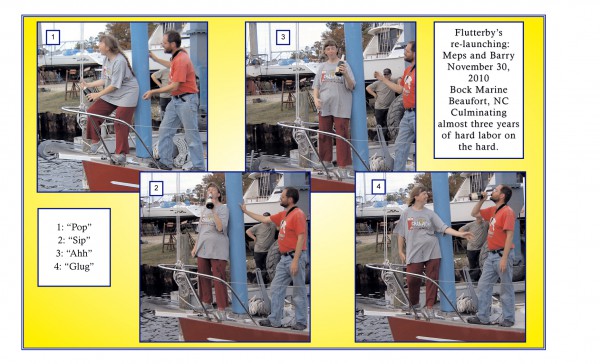We left on Saturday, December 1st, and we’ve now done 4 whole days of cruising. Every day is different, so here’s a little trip report on the different days.
Day 0: We decided to drop off the rental car in an unorthodox manner. We should have taken Billy and Lizzie up on their offer of a ride.
But no, I dropped Barry and two untested inflatable kayaks at a boat ramp on Broad Creek, then drove the car to the airport to return it. I hurried over to the cab stand, making a cab driver very, very unhappy. She and her fellow luckless cab-drivers had been sitting there for 5 hours, waiting. Now she was the first cab in line, watching the one evening flight land and hoping to score one big fare, maybe a bunch of wealthy golfers. Instead, she had to take me three miles to a gravel boat ramp, and the second cab in line scored the wealthy golfers.
Because of a UPS snafu (paddles came a day late), we launched the kayaks at sunset, and poor Barry had underinflated his. While I paddled along like a happy duck, he struggled valiantly, unable to keep up. Darkness fell, and we were out without a light. Luckily, we only saw one other boat in the entire 3-mile route, and they, at least, had a spotlight.
Day 1: We cast off our lines with trepidation and excitement and headed down Broad Creek into Calibogue Sound. After the previous night’s excitement, I was hoping for something a little less nerve-wracking.
And it was an excellent day, cruising behind Hilton Head to Port Royal Sound, then behind St. Helena and Lady’s Island past my beloved Beaufort, S.C. We got used to the noisy, vibrating engine and took turns at the helm, navigating with a chartbook and GPS.
This was familiar territory, since we’d done the same route, beginning at Port Royal, aboard Cayenne in 2004.
At the end of the day, we anchored in the South Edisto River, completely alone, with a glorious sunset. I heard the sound of wild pigs on shore, and once, I saw a dark shape moving around, but there were no lights or signs of humans anywhere.
Day 2: A curious dolphin cruised up to our stern this morning. He’d probably never seen anyone eating Killer Oatmeal before.
After the antibellum houses of Beaufort, there were few houses for many miles, then the Charleston suburbs began. We went through narrow cuts and waterways with melodious names, like the Ashepoo river and Toogoodoo Creek. At the Wappoo Creek Bridge, we had a slight problem — on the radio, the bridge tender said she didn’t see us, so she was going to open the bridge for another boat, and we’d have to wait when we arrived. We were frustrated, because we were within sight of the bridge! Finally, the bridge tender saw us and held the bridge open for us for a long, long time. We figured she was embarrassed — 99% of the boats are traveling southbound, so she wasn’t looking on the south side of the bridge, where we were clearly visible.
In Charleston Harbor, we passed within hailing distance of a sailboat, and the skipper called out, “I’ve seen you here before! I know that red hull!” I don’t think this boat has been up to Charleston, though…maybe he remembers Cayenne? We do look like her little sister!
Speaking of other Freedoms, our Charleston destination was Cooper River Marina, where we rendezvoused with Doug and Donna of Phoenix, another Freedom 33. She’s actually their second F33; when the first one was lost in a fire, Donna found this one for sale. She’s in beautiful condition, much better than ours, and we enjoyed looking at all the nice touches. It’s fun to see the differences and the similarities in the two boats. We especially enjoyed sharing sea stories and fairy tales with Doug and Donna, who took us to a wonderful Irish pub in North Charleston for dinner. I can’t wait to come back to Charleston after our refit and do some buddy-boating with them — we could have a two-boat race!
Day 3: Today was my first grounding, when I went too far out of the way of a huge motor yacht and got stuck in the muck. Luckily, the tide helped me off, and we were only held up for about 5 minutes.
All morning, Barry had been futzing with the sails and rigging, begging me oh-please-oh-please could we raise the sails today? I was hesitant, because despite the fact that the wind was perfect for sailing, we were traveling in a ditch with no room to maneuver (as evidenced by my grounding).
But he was so persistent, we raised the main, and then we just flew like an arrow down the waterway at speeds up to 7 knots. It was two hours of delightful sailing, and it reminded me of an article I read about the famous Joshua Slocum, who came through this area in 1888 aboard the Liberdade. He’d gotten into one of the harbors, but the weather turned and he couldn’t get back out. So he started sailing through the marshes, and he got lost. He hailed a local hunter to ask him where this particular “ditch” went, and the hunter said, “Why, stranger, my gran’ther digged that ditch.”
So this local pilot, who had never heard of a vessel sailing from Brazil through his backyard, came aboard and led him practically to Beaufort, N.C.
If Slocum could sail in a ditch, so could we!
However, we lost valuable time sailing, and when we reached the anchorage we’d chosen, it was too exposed. I throttled up and headed for Georgetown, but the sun was setting as I did so. Unlike our kayak adventure on Day 0, we did have lights, and the computer was a great help for navigating (Slocum didn’t have either of those).
Navigating in the dark, in a place marked with something they call day markers, is not a good idea. We were lucky that this one spot happens to be suitable for nighttime navigation, with lit markers and ranges for big boats coming in from the Atlantic.
After we dropped the anchor, I told Barry, “You couldn’t pay me to do that again!”
Day 4: Ah, a short day. We cruised up the Waccamaw river, lined with trees dripping with Spanish moss. We saw a deer swimming across the channel, dolphins, and hawks. No bald eagles, but we’d seen one yesterday.
A yacht that looked like a converted fishing boat passed by, with the name Frog Kiss on the stern. We were commenting on the boat when they hailed us on the radio, saying, “Red Freedom 33, this is Frog Kiss.” We had a nice little chat with them — former owners of a Freedom 44 who have gotten too old for sailing, but who miss their Freedom. We are realizing that we are now part of the Freedom Fraternity!
We dropped the hook early today, in the exact same place we anchored in 2004. It’s an oxbow off the main channel with an old wrecked boat on shore. Then it was time for a nap (for me), and some futzing (for Barry). Later in the afternoon, we hoisted the sails and I took one of the kayaks out for some photos. We took some photos of ourselves inside the sails — one of those weird things you can only do with wraparound sails!
Our resident gecko came out this evening, and we took some photos of him, too. He lives in the mizzen sail somewhere.
Tomorrow, we’ll pass through the long narrow canal behind Myrtle Beach, and we hope to find some wi-fi signal there to post this and some photos. We’ve been getting lots of requests — actually, demands — for photos of the boat.
